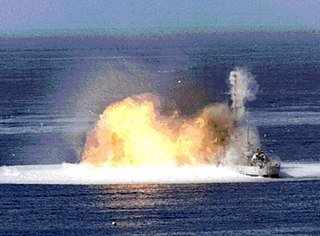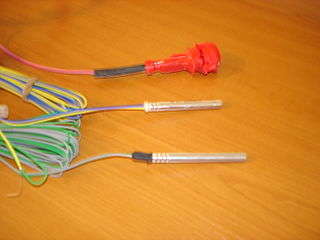
A thermobaric weapon, also called an aerosol bomb, a vacuum bomb or a fuel air explosive (FAE), is a type of explosive that uses oxygen from the surrounding air to generate a high-temperature explosion. The fuel–air explosive is one of the best-known types of thermobaric weapons.

A detonator, frequently a blasting cap, is a device used to trigger an explosive device. Detonators can be chemically, mechanically, or electrically initiated, the last two being the most common.
Brisance is the shattering capability of a high explosive, determined mainly by its detonation pressure. The term can be traced from the French verb "briser" ultimately derived from the Celtic word "brissim".

ANFO ( AN-foh) (or AN/FO, for ammonium nitrate/fuel oil) is a widely used bulk industrial explosive. It consists of 94% porous prilled ammonium nitrate (NH4NO3) (AN), which acts as the oxidizing agent and absorbent for the fuel, and 6% number 2 fuel oil (FO). The use of ANFO originated in the 1950s.

Project Plowshare was the overall United States program for the development of techniques to use nuclear explosives for peaceful construction purposes. The program was organized in June 1957 as part of the worldwide Atoms for Peace efforts. As part of the program, 31 nuclear warheads were detonated in 27 separate tests. A similar program was carried out in the Soviet Union under the name Nuclear Explosions for the National Economy.
Representational state transfer (REST) is a software architectural style that describes a uniform interface between decoupled components in the Internet in a Client-Server architecture. REST defines four interface constraints:

Tannerite is a brand of binary explosive targets used for firearms practice and sold in kit form. The targets comprise a combination of oxidizers and a fuel, primarily aluminium powder, that is supplied as two separate components that are mixed by the user. The combination is relatively stable when subjected to forces less severe than a high-velocity bullet impact. A hammer blow, the product being dropped, or impact from a low-velocity bullet or shotgun blast will not initiate a reaction. It is also designed to be non-flammable, although its explosion can ignite flammable material.

Hexamethylene triperoxide diamine (HMTD) is a high explosive organic compound. HMTD is an organic peroxide, a heterocyclic compound with a cage-like structure. It is a primary explosive. It has been considered as an initiating explosive for blasting caps in the early part of 20th century, mostly because of its high initiating power and its inexpensive production. As such, it was quickly taken up as a primary explosive in mining applications. However, it has since been superseded by more (chemically) stable compounds such as dextrinated lead azide and DDNP. HMTD is widely used in amateur-made blasting caps.

A nuclear explosion is an explosion that occurs as a result of the rapid release of energy from a high-speed nuclear reaction. The driving reaction may be nuclear fission or nuclear fusion or a multi-stage cascading combination of the two, though to date all fusion-based weapons have used a fission device to initiate fusion, and a pure fusion weapon remains a hypothetical device.
This is a non-exhaustive list of notable antivirus and Internet Security software, in the form of comparison tables, according to their platform and their operating systems.

Aviation Thermobaric Bomb of Increased Power, nicknamed "Father of All Bombs", is a Russian-designed, bomber-delivered thermobaric weapon.
Standoff distance is a security term that refers to measures to prevent unscreened and potentially threatening people and vehicles from approaching within a certain distance of a building, car, or other shelter, roadblock or other location, or to a person such as a law enforcement officer or VIP, or to a friendly area / location.

Cloud computing is the on-demand availability of computer system resources, especially data storage and computing power, without direct active management by the user. Large clouds often have functions distributed over multiple locations, each location being a data center. Cloud computing relies on sharing of resources to achieve coherence and typically using a "pay-as-you-go" model which can help in reducing capital expenses but may also lead to unexpected operating expenses for unaware users.
Eucalyptus is a paid and open-source computer software for building Amazon Web Services (AWS)-compatible private and hybrid cloud computing environments, originally developed by the company Eucalyptus Systems. Eucalyptus is an acronym for Elastic Utility Computing Architecture for Linking Your Programs To Useful Systems. Eucalyptus enables pooling compute, storage, and network resources that can be dynamically scaled up or down as application workloads change. Mårten Mickos was the CEO of Eucalyptus. In September 2014, Eucalyptus was acquired by Hewlett-Packard and then maintained by DXC Technology. After DXC stopped developing the product in late 2017, AppScale Systems forked the code and started supporting Eucalyptus customers.

VMware vSphere is VMware's cloud computing virtualization platform.
Software-defined data center is a marketing term that extends virtualization concepts such as abstraction, pooling, and automation to all data center resources and services to achieve IT as a service (ITaaS). In a software-defined data center, "all elements of the infrastructure — networking, storage, CPU and security – are virtualized and delivered as a service."
Robot as a service or robotics as a service (RaaS) is a cloud computing unit that facilitates the seamless integration of robot and embedded devices into Web and cloud computing environment. In terms of service-oriented architecture (SOA), a RaaS unit includes services for performing functionality, a service directory for discovery and publishing, and service clients for user's direct access. The current RaaS implementation facilitates SOAP and RESTful communications between RaaS units and the other cloud computing units. Hardware support and standards are available to support RaaS implementation. Devices Profile for Web Services (DPWS) defines implementation constraints to enable secure Web Service messaging, discovery, description, and eventing on resource-constrained devices between Web services and devices.

A water-gel explosive is a fuel sensitized explosive mixture consisting of an aqueous ammonium nitrate solution that acts as the oxidizer. Water gels that are cap-insensitive are referred to under United States safety regulations as blasting agents. Water gel explosives have a jelly-like consistency and come in sausage-like packing stapled shut on both sides.
Firebase Cloud Messaging (FCM), formerly known as Google Cloud Messaging (GCM), is a cross-platform cloud solution for messages and notifications for Android, iOS, and web applications, which as of June 2022 can be used at no cost. Firebase Cloud Messaging allows third-party application developers to send notifications or messages from servers hosted by FCM to users of the platform or end users.
The zero trust security model, sometimes known as perimeterless security, describes an approach to the design and implementation of IT systems. The main concept behind the zero trust security model is "never trust, always verify,” which means that devices should not be trusted by default, even if they are connected to a permissioned network such as a corporate LAN and even if they were previously verified. Most modern corporate networks consist of many interconnected zones, cloud services and infrastructure, connections to remote and mobile environments, and connections to non-conventional IT, such as IoT devices. The reasoning for zero trust is that the traditional approach — trusting devices within a notional "corporate perimeter", or devices connected via a VPN — is not relevant in the complex environment of a corporate network. The zero trust approach advocates mutual authentication, including checking the identity and integrity of devices without respect to location, and providing access to applications and services based on the confidence of device identity and device health in combination with user authentication.










